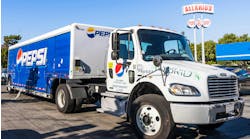Switching to a winterized diesel during the coldest months of the year can be an important move to protect your equipment in the harshest elements. And while it’s ideal to start using a winterized fuel early in the season to avoid engine issues, it’s never too late to move to a specially formulated a winterized diesel like Cenex Seasonally Enhanced or Cenex Wintermaster.
But good news — even if you haven’t yet made the switch, it’s still not too late to optimize your equipment’s winter performance with a complete and balanced additive package found in Cenex winterized premium diesel fuels. Here are a few things to know about winterizing your diesel later in the season:
1. Know your fuel’s cloud point. A diesel fuel’s cloud point is the temperature at which wax crystals begin to appear. Generally speaking, it ranges from 4 to 14 degrees Fahrenheit. In a perfect world, switching to a winterized premium diesel should happen well before temperatures drop that low.
2. Improve your equipment’s operability. Ultimately, the goal of using a winterized premium diesel is to improve your equipment’s operability, which is the lowest temperature at which your equipment functions without losing power. Winter blends like Cenex Wintermaster come packed with cold flow improvers and anti-wax settling agents that prevent wax crystals from forming and settling in your tank, keeping your equipment operable at temperatures down to 30 below zero. Cenex Seasonally Enhanced fuels are also specially formulated to meet your seasonal needs, providing outstanding shoulder season flexibility in more moderate climates.
3. Blend a #1 with your #2. If you didn’t quite make the switch before temperatures dropped, it’s not too late. The only difference now is you’ll want to add one extra step. Before filling up with winterized premium diesel, prepare your tank by blending a #1 with your standard #2, blending the mixture entirely before adding a Cenex Seasonally Enhanced or Cenex Wintermaster. Taking this extra step prevents dilution, which can lead to inoperability down the road.
4. Watch out for water. We can’t talk about winter fuel without mentioning water. Water’s freezing point (32 degrees Fahrenheit) is much higher than the average cloud point, so make sure there is no water in the tank or system.
While switching to a winter blend is best done earlier rather than later, it’s not too late to transition now. And don’t forget, any time you have questions or concerns, your Local Cenex dealer is here to help.
Photo: Lex Valishvili

Voice your opinion!
Voice your opinion!
To join the conversation, and become an exclusive member of FleetOwner, create an account today!
Latest from Emissions & Efficiency
Latest from Emissions & Efficiency


